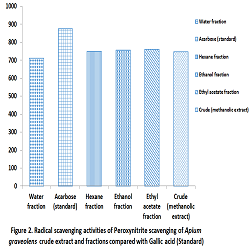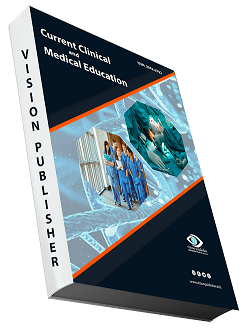Antioxidant Potential (Peroxynitrite scavenging, Singlet oxygen scavenging, and Hypochlorous acid scavenging) and Anti-Inflammatory Effect of Apiumgraveolens and Investigation of Its Bioactive Natural Compound Using FTIR Analytical Technique
Keywords:
Peroxynitrite, Singlet oxygen, Hypochlorous acid scavenging, ApiumAbstract
The objective of our study is to conduct a chemical analysis of Apium
graveolens and to assess the anti-inflammatory and antioxidant capabilities of several
extracts, including methanol, ethyl acetate, ethanol, hexan, and water. To get ready for
FTIR analysis, a tiny quantity of powdered samples was dissolved in KBr and then
compressed into a thin film. A wave number range spanning from 4000 cm−1 to 500 cm
−1 was used to gather data on the transmittance of infrared light. The albino rats used in
the studies ranged in weight from 175 to 225 gram. The animal breeding house was the
source for the animals. The animals in group I were utilized as a control group and were
given maize oil as a vehicle. 100 mg/kg Di-(2- ethylhexyl) phthalate were the positive
controls in all trials involving Apium graveolens methanol fraction. Group 1 consisted of
Di-(2- ethylhexyl) phthalate at a concentration of 100 mg/kg, Groups 2, and 3 of
fractions of Apium graveolens at concentrations of 0.50 mL/kg, and 0.75 mL/kg,
respectively. Di(2-ethylhexyl)phthalate causes chronic hepatotoxicity in rats. Hence, we
find that taking di(2-ethylhexyl) phthalate orally (1000 mg/kg body weight/day) as
laboratory tested for 4 weeks in rats resulted in a noticeable and significant increase in
the levels of serum enzymes such as (SGOT), (SGPT), and (ALP). Hence, we found that
taking A. graveolens seed extract (250 mg/kg.w./day) for 4 weeks leads to a significant
and significant recovery of these biochemical parameters towards the normal stable state
compared to di(2-ethylhexyl) phthalate-treated rats and their control. The results of this
study lend credence to the traditional medicinal usage of Apium graveolens, which has
been found to have anti-inflammatory and antioxidant properties.
Downloads
References
Wu S-Y, Shen J-L, Man K-M, et al. An emerging translational model to screen potential medicinal plants for nephrolithiasis, an independent risk factor for chronic kidney disease. Evid Based Complement Alternat Med. 2014;2014:972958
Saki K, Bahmani M, Rafieian-Kopaei M. The effect of most important medicinal plants on two importnt psychiatric disorders (anxiety and depression)—a review. Asian Pac J Trop Med. 2014;7:34–42.
Kooti W, Moradi M, Ali-Akbari S, Sharafi-Ahvazi N, Asadi-Samani M, Ashtary-Larky D. Therapeutic and pharmacological potential of Foeniculum vulgare Mill: a review. J Herb Med Pharmacol. 2015;4:1–9.
Kooti W, Farokhipour M, Asadzadeh Z, Ashtary-Larky D, Asadi-Samani M.The role of medicinal plants in the treatment of diabetes: a systematic review. Electronic Physician. 2016;8:1832–1842.
Asadi-Samani M, Kooti W, AE, Shirzad H. A systematic review of Iran’s medicinal plants with anticancer effects. J Evid Based Complementary Altern Med. 2015;21:145–153.
Kooti W, Ali-Akbari S, Asadi-Samani M, Ghadery H, Ashtary-Larky D. A review on medicinal plant of Apium graveolens . Adv Herb Med. 2014;1:48–59.
Sowbhagya HB, Srinivas P, Krishnamurthy N. Effect of enzymes on extraction of volatiles from celery seeds. Food Chem. 2010;120:230–234.
Liu SC, Lin JT, Wang CK, Chen HY, Yang DJ. Antioxidant properties of various solvent extracts from lychee (Litchi chinenesis Sonn.) flowers. Food Chem. 2009;144:577–81.
Oktay M, Gülçin I, Küfrevioglu OI. Determination of in vitro antioxidant activity of fennel (Foeniculum vulgare) seed extracts. LWT-Food Sci Technol. 2003;36:263–71.
Balasundram N, Sundram K, Samman S. Phenolic compounds in plants and agri-industrial by products: antioxidant activity, occurrence, and potential uses. Food Chem. 2006;99:191–203. 11. Naskar S, Mazumder UK, Pramanik G, Bala A, Haldar PK, Islam A, et al. Comparative in vitro antioxidant activity of different parts of Cocos nucifera (Linn.) on reactive oxygen and nitrogen species. Int. J Pharm Pharm Sci. 2011;3:104–7.
Li, M. Y.; Hou, X. L.; Wang, F.; Tan, G. F.; Xu, Z. S.; Xiong, A. S. Advances in the Research of Celery, an Important Apiaceae Vegetable Crop. Crit. Rev. Biotechnol. 2018, 38(2), 172–183.
Huang, W.; Wang, G. L.; Li, H.; Wang, F.; Xu, Z. S.; Xiong, A. S. Transcriptional Profiling of Genes Involved in Ascorbic Acid Biosynthesis, Recycling, and Degradation during Three Leaf Developmental Stages in Celery. Mol. Genet. Genomics. 2016, 291(6), 2131–2143
Yao, Y.; Sang, W.; Zhou, M.; Ren, G. Phenolic Composition and Antioxidant Activities of 11 Celery Cultivars. J. Food Sci. 2010, 75(1), C9–C13.
Zujovic, Z.; Chen, D.; Melton, L. D. Comparison of Celery (Apium Graveolens L.) Collenchyma and Parenchyma Cell Wall Polysaccharides Enabled by Solid-state 13C NMR. Carbohydr. Res. 2016, 420, 51–57.
CCME 7 (2), 01-08 (2024) Vision Publisher|8
Ganzera, M.; Sturm, S. Recent Advances on HPLC/MS in Medicinal Plant analysis—An Update Covering 2011–2016. J. Pharm. Biomed. Anal. 2018, 147, 211–233.
Syukri, D.; Thammawong, M.; Naznin, H. A.; Kuroki, S.; Tsuta, M.; Yoshida, M.; Nakano, K. Identification of a Freshness Marker Metabolite in Stored Soybean Sprouts by Comprehensive Mass-spectrometric Analysis of Carbonyl Compounds. Food Chem. 2018, 269, 588–594.

Downloads
Published
How to Cite
Issue
Section
License

This work is licensed under a Creative Commons Attribution 4.0 International License.
Current Clinical and Medical Education













